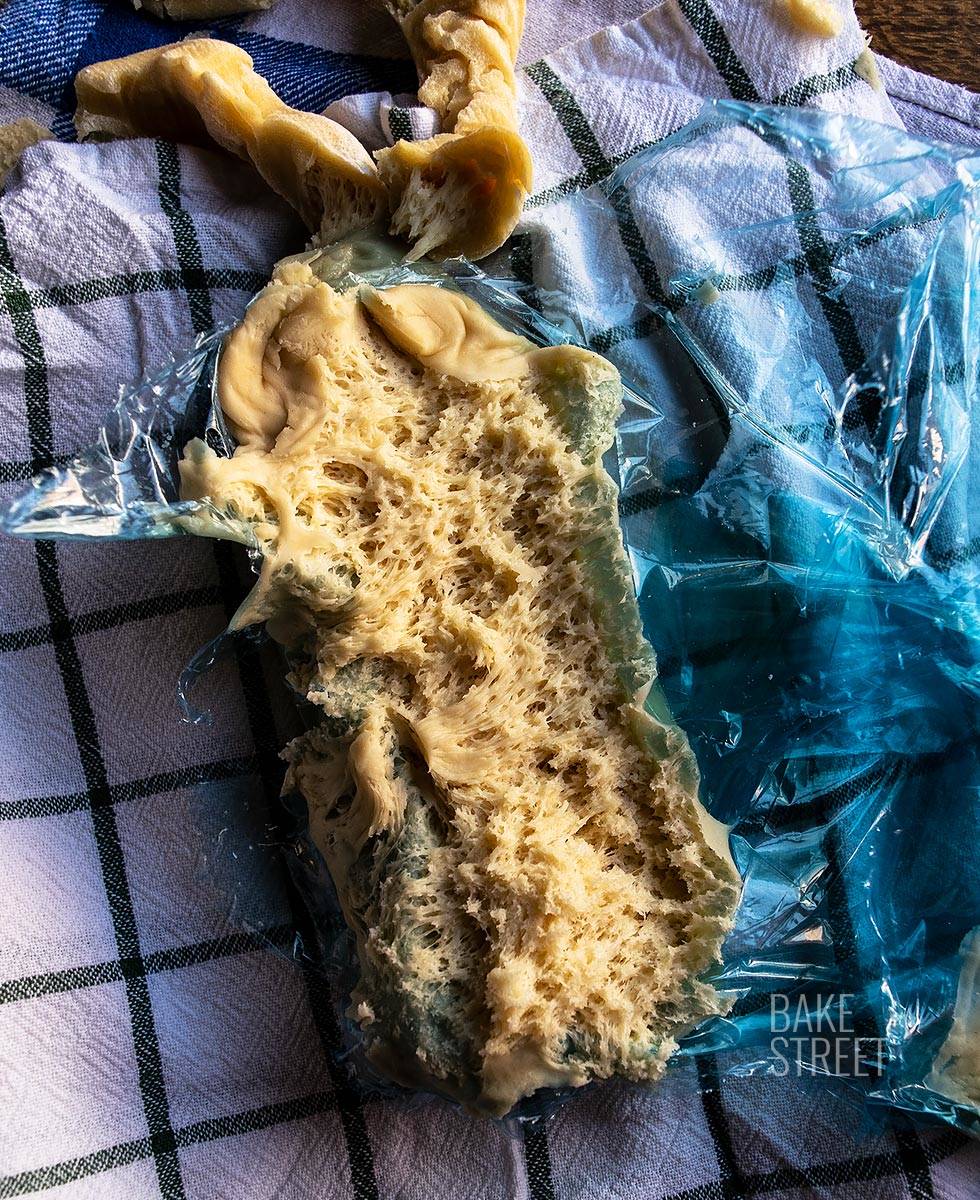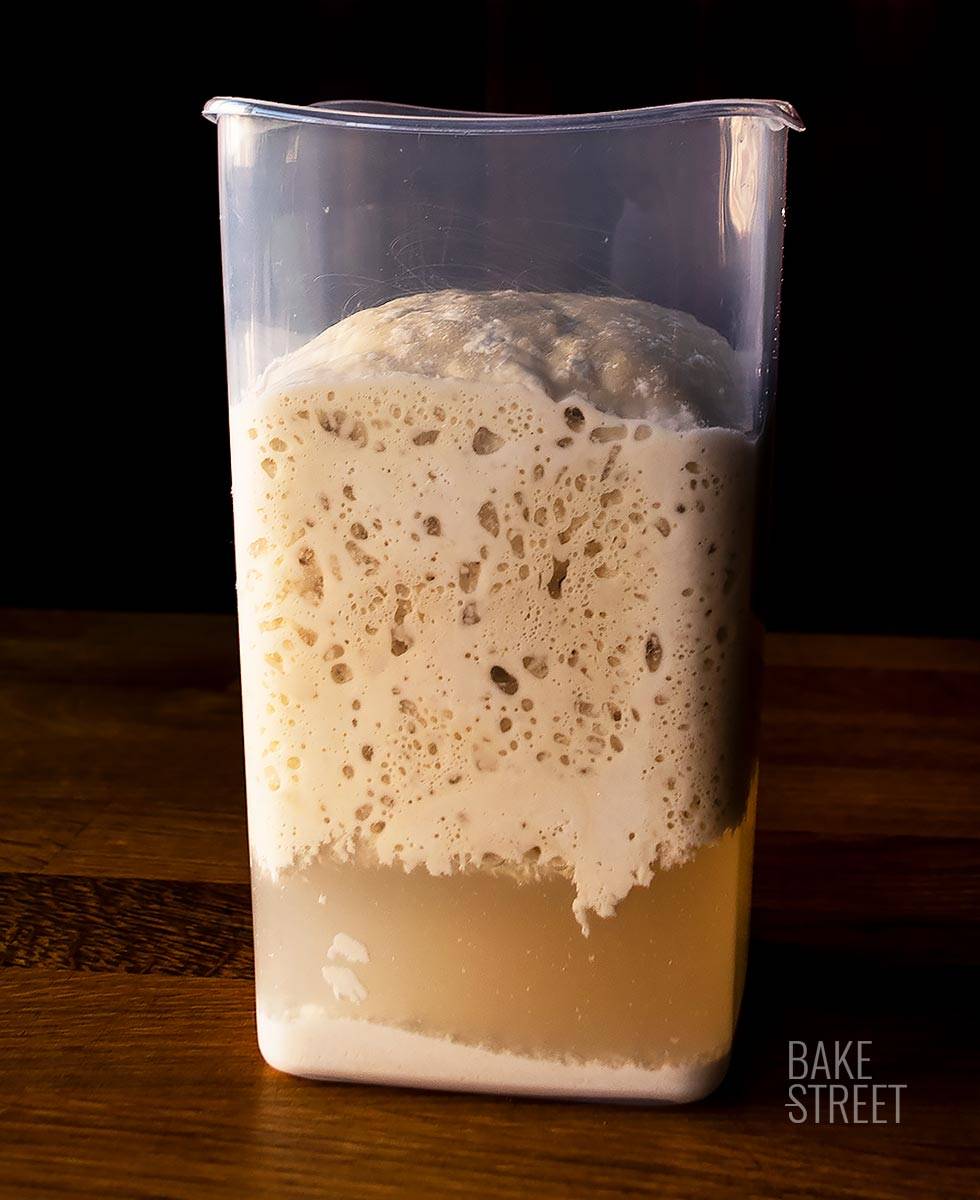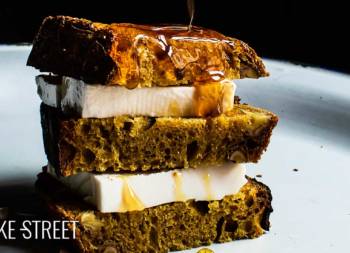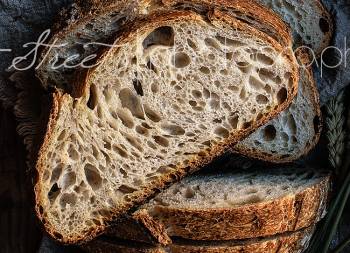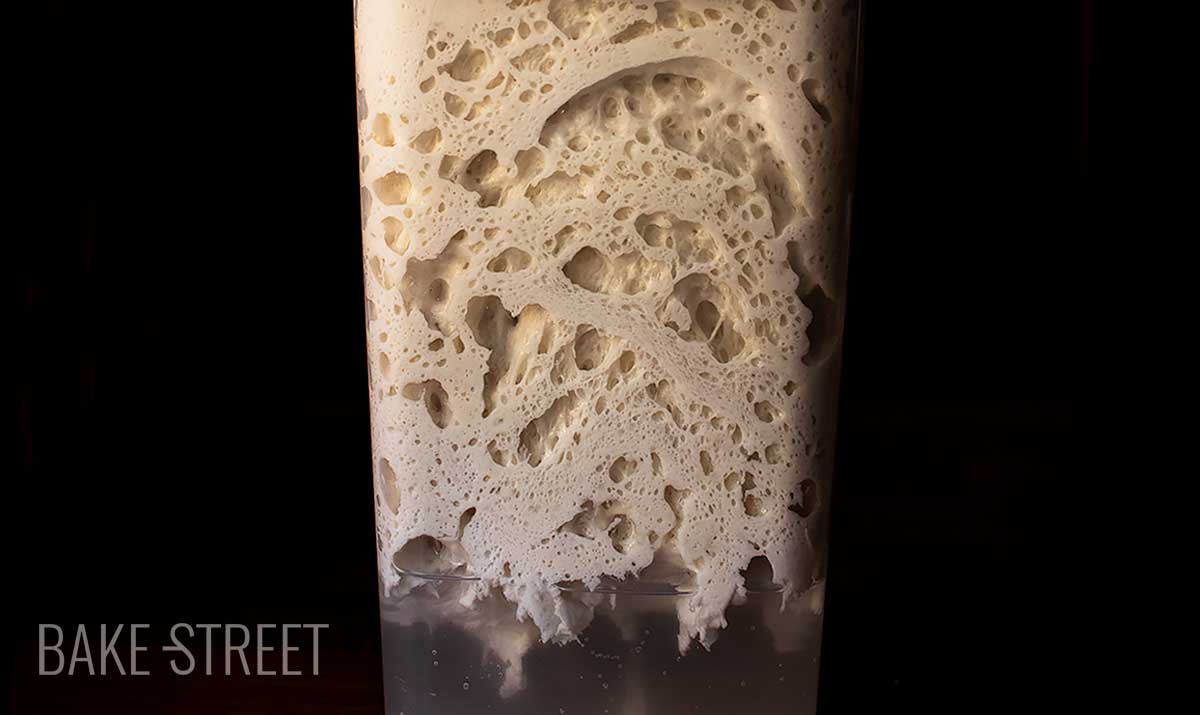
How to make Stiff Sourdough for Panettone
I hope you’re ready to read and I’ll bore you with a lot of information. Today I’m going to talk to you and tell you how to make stiff sourdough for Panettone. You know that these last two weeks I have been making through my IG stories, a daily step by step process of a stiff sourdough to make future panettones or doughs in general.
In fact, this SD can be used to make other types of dough such as all kinds of breads and enriched doughs. If you remember my last post, Pandoro made with stiff sourdough, is made from this SD. In fact, with the leftovers that I had after making the daily refreshments. It’s a strong and powerful bug.
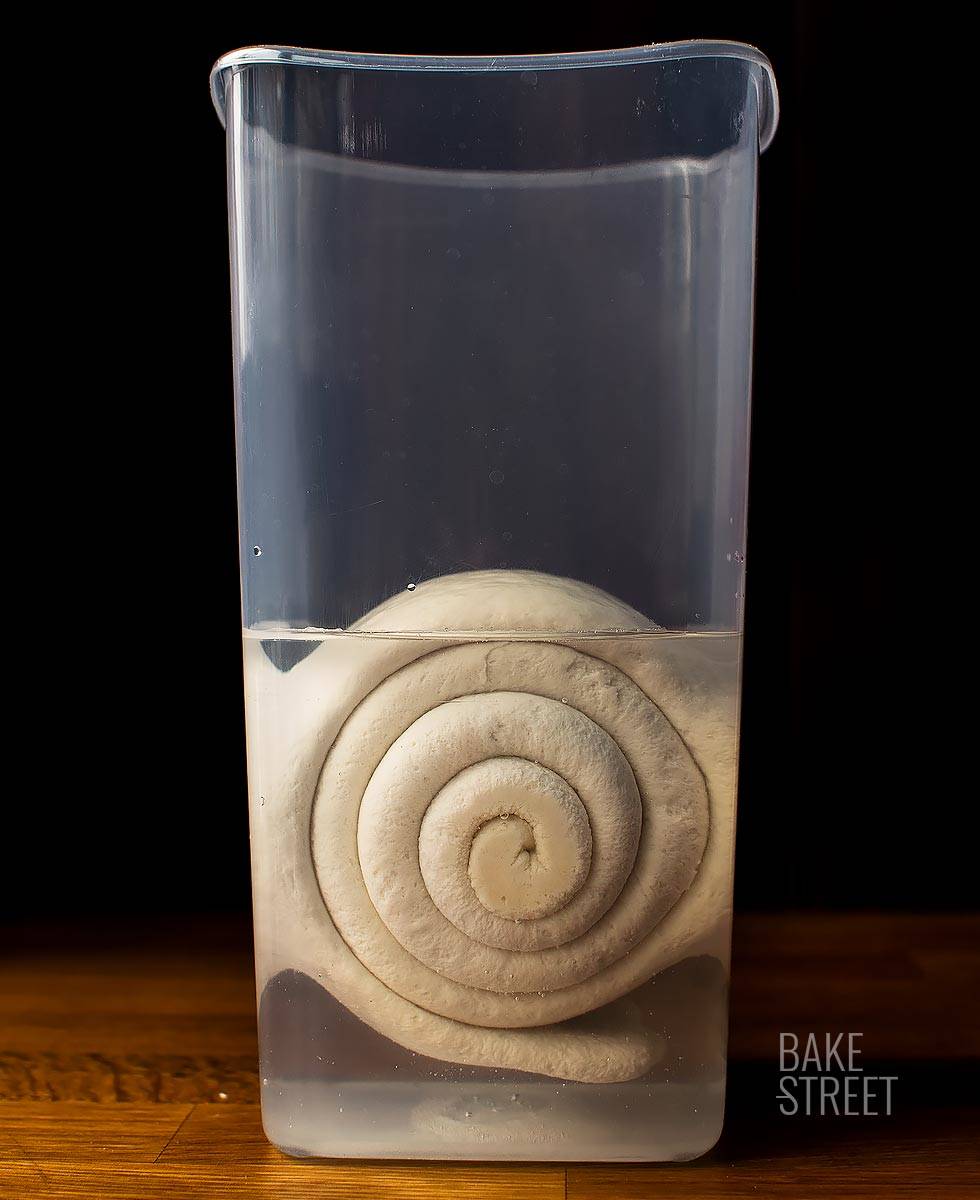
Refreshed and floating sourdough after 2 hours
This will be the first of three posts that I am going to share talking and explaining the whole process of a Panettone. The first will be how to make a stiff SD and maintain it, the second how to make the three preparatory refreshments and, finally, the elaboration of the Panettone.
I have decided to divide it into 3 different posts for various reasons. The main one is that otherwise it would be too much information in a single post and in the end we don’t know anything. Besides being able to have the three parts of the process divided, that way it will be much easier to find and go directly to the information we need.
A natural and easy process.
I have to say that over all the years I’ve been blogging, they’re on their way to seven, I’ve made several sourdoughs. I have mine that has been with us for almost six years, my beautiful princess. But for various reasons, workshops or tests, I have done many others. I can assure you that the process I leave you today is not only easy to do, but also gives frankly impressive results.
The method to make it I have learned from Max “Aquí hay buen pan“, which surely many of you already know. Also I have combined his process with all the theory of the book “PH 4.1. Scienza e artigianalità della pasta lievitata”, I know that I have recommended it to you a hundred thousand times, but it is an extraordinary book. Really. For those of you who want to go deeper and carry out a more theoretical knowledge about the process of a stiff SD, this book cannot be missing from your shelves. I just admire it.

To start with, we will need to ferment apple water for 24 hours to start feeding it with Manitoba flour or a very strong flour with W=380-400 (Canadian flour, for example). I have seen elaborations that also use flours with a force of W=360, but under no circumstances can you use any that is inferior to that. As a common bread flour, results are not going to be good, believe me.
It’s a journey that, already ahead of you, requires a lot of discipline, passion, dedication and time. You will spend 15 days taking care of it and making sure that it is always in its comfort zone.
What will you get in return? The best panettones, pandoros, enriched doughs, breads, laminated doughs… of your life. Wow, how exaggerated… Not at all. I give you my word.
Factors to consider when making a stiff SD.
When we are going to create a SD what we will do is give rise to a group of bacteria capable of living in a range of temperature between 39º-95ºF / 4º-35ºC, but keeping them in an environment around 78,8º – 86ºF / 26º-30ºC we will have them in their comfort zone. If we exceed the maximum temperature, our yeasts will begin to suffer and when they reach 131ºF / 55ºC, they will die.
Not all yeasts have the same fermentation power.
We need to create a living being that tolerates incredibly surprising livelihoods. Microorganisms capable of living and breathing in the presence of oxygen, as well as surviving and fermenting in anaerobic conditions. Capable of adapting their metabolism to change situations. This step is fundamental because we need yeasts that act on both metabolisms.

SD on its 7th day of evolution
When we knead, we incorporate a large amount of oxygen into the dough that favors the environment for the natural metabolism of yeasts. In this way we favor their growth and reproduction. When the oxygen is exhausted, instead of dying which is what would happen to us, they change their metabolism to anaerobic, they survive and the responsible phase of alcoholic fermentation begins to occur. From this moment on, they will produce carbon dioxide and ethyl alcohol. A very important step in the fermentation process.
For this reason it will be very important that we knead and refine our dough very well before placing it for its fermentation process.
What factors influence the fermentation of our SD.
- PH or acidity: Predicts the acidic environment as it facilitates reproduction and fermentative activity. The optimum pH would be between 3.9 – 5.3, the ideal being 4.1. The more acidic the pH, the more difficult it will be for the fermentation process to take place because it inhibits it. A pH higher than 5.3 slows it down.
- Sugar, salt and butter: These ingredients may stimulate or block fermentation based on the amount used.
- Temperature: This factor is very important for fermentation and must be controlled. When a yeast dough exceeds the temperature of 75,2ºF/24ºC, it has been observed that its fermentative capacity increases between a range of 1.8-12% for each additional degree. This factor denotes the great importance of temperature control when working with doughs. Despite being able to withstand temperatures up to 95ºF/35ºC, there are signs of decomposition that begin at 89,6ºF/32ºC.
- Water: Depending on the hardness of the water, the metals present in it and the chlorine, we can find different behaviors when doughs carry out the fermentation process. These 3 elements are variables that directly affect and can inhibit the proper development of yeasts. For example, a type of water that is rich in calcium and magnesium will harden the gluten mesh which will lead to a slowing down of the fermentation process. When we are not sure of the quality of our water, it is better to make refreshments with mineral water. But be careful, always looking at the composition to know the amount of waste.

SD on its 9th day of evolution
Fermentation.
Fermentation is an anaerobic oxidative chemical process that transforms sugars into gas (i.e., carbon dioxide), alcohol (ethanol) and organic acids, among which lactic and acetic acids predominate.
Products made with natural yeasts have 2 types of fermentation:
- Alcoholic: Base of alcoholic beverages and bakery products.
- Bacterial or lactic: Produces less gas. It is responsible for the taste and aroma during cooking. Fermentation acts with ethanol and gives rise to a series of aromatic colorants that give the product a unique aroma and perfume. Hence the difference between carrying out a product with yeast or SD, the latter will have more flavor, smell, longer shelf life and better preservation.
The quality of a product is directly related to lactic fermentation.
A good SD will have 60% lactic acid, 20% acetic acid and 20% other organic acids. In addition, this acid has a strong anti-mould action and prevents rapid drying of the product.
There are two methods of doing this.
When we want to make a solid dough for panettone we can do it in two ways:
- Dry
- Immersed in water
In my case I am going to teach you how to make it submerged in water for many reasons. The main one is that it is much easier for me than the dry one since it requires to keep it in a cloth and to tie it every day. In my opinion it is heavier, I consider that it is much easier to refresh it following the process that I will show you, to shape a cylinder and to submerge it in water.

Dry upper part of the stiff SD on its 6th day of evolution
Also refreshing a SDs under water brings us many benefits for when we want to use it in a preparation:
- A stiff SD submerged under water is much less acidic than a stiff dry SD because it dilutes the acidity through the water that remains in its lower part once it grows and floats.
- It will be much easier for us to control their pH.
- It reduces the risk of acidifying impasto and improves development in the oven.
- Products with a longer shelf life are obtained.
States where ourSD may be.
- Lievito or mature SD: It will be aromatic, sweet and slightly acidic with a raw white color. Its consistency will be firm and with elongated alveoli. It will have a pH of 4.1 – 4.3.
- Lievito or very strong SD: A SDs in this state can be of two forms; acidic and non-acid. A non-acidic SD produced too many yeasts breaking the balance with lactic bacteria. Acid, but not too much. A symptom that denotes an extremely strong SD is that in refreshments it will be ready before 3 hours. Its taste can be bitter, grayish and a PH <4.
- Lievito or weak SD: Its taste is very sweet without notes of acidity, white color, few alveoli and a smell reminiscent of flour.
In the next post, that I will talk about the 3 preparatory refreshments, I will also tell you what to do in the previous cases to know how to proceed to rectify the acidity or excessive force in a SD or if, on the contrary, it is weak.

SD on its 12th day of evolution
IMPORTANT.
- The final temperature of the impasto should always be between 78,8º-82,4ºF / 26º-28ºC. For this, the water with which we feed the SD must be at 86ºF/30ºC to compensate for the cold water in the bath.
- The ambient temperature in the night rest must be between 64º-66ºF / 18º-19ºC.
- Night rest time can be around 16-18 hours between both refreshing cycles.
- In the post you will see 2 types of SD shaping. The first one that consists of a simple fold I made it only during the first 2 days, but a friend recommended me to do the shaping in spiral and refining the dough a lot. In this way, the SD has more strength and disintegrates less easily.
How to keep our SD for longer periods of time without making daily refreshments?
Once we have our active SD we can store it in the fridge for a period of 7-21 days. But keep in mind that the longer you spend in the cold, the greater its acidity will be.
To keep it for 7 days: We will proceed to make the refreshment in the same way we have always done, submerged in water, let it float to the surface and refrigerate at 39ºF/4ºC.
To keep it 14-21 days: We will proceed to make refreshment using 3-4 times the weight of the SD in flour plus 45% of water with respect to the weight of the flour. We will do it in the same way that we have always done, submerge in water, let it float to the surface and refrigerate at 39ºF/4ºC.
MATERIAL WE’LL NEED FOR THE WHOLE PROCESS:
- Manitoba or high strength flour, W=380-400
- An elongated container to ferment the SD. Mine measures 8,65 x 3,1 x 3,5 inches /22 cm x 8 cm x 9 cm (height and base) to ferment the amount I leave you. In case you do less, you should look for a suitable container.
- A zip-type or freeze-type plastic bag
- Two cloths of cotton or linen
- Rope
- Bowls
- Roller pin
- Digital scale
- Digital thermometer
Ingredients
FIRST DAY:
- 1 good quality apple
- same weight of water as grated apple at 86ºF/30ºC
SECOND DAY:
- 200 g apple water yeast
- 200 g Manitoba flour, W=380-400
THIRD-FOURTH DAY:
- 200 g SD
- 200 g Manitoba flour, W=380-400
FIFTH DAY:
- 200 g SD
- 200 g Manitoba flour, W=380-400
- 30-50% maximum water in relation to the weight of the flour (60-80 g)
SIXTH - FIFTEENTH DAY:
- 200 g SD
- 200 g Manitoba flour, W=380-400
- 30-50% maximum water in relation to the weight of the flour (60-80 g)
Instructions
FIRST DAY
- Wash the apple very well, dry with paper towels.
- Cut into quarters and grate the whole apple with the skin included.
- Weigh the amount of apple we have grated.
- Pour all the grated pulp together with the juice that may have been released into an airtight glass container and add the same amount of water that we have obtained weight of grated apple. In my case it was 200 g of grated apple and 200 g of water at 86ºF/30ºC.
- Close well and place inside the oven to help maintain a constant temperature of 82º-86ºF / 28º-30ºC. If your oven does not allow the light to be turned on or the light is turned off from time to time for safety reasons, you can heat a cup of water and put it inside the oven. Use a temperature thermometer to control the temperature inside the oven.
- Turn on the oven light and leave for 24 hours.

SECOND DAY
- Drain the entire contents of the container to remove the apple pulp and keep the fermented water. Weigh the amount of water we have obtained.
- In a bowl add the same amount of fermented water and Manitoba flour. In my case it was 200 g of fermented water and 200 g of Manitoba flour.
- Mix well with a spoon until a homogeneous mixture is obtained.
- Pour the mixture into an elongated container, make a mark on the outside (with a felt-tip pen or by placing an elastic band) to know how far it goes. In this way we can control how much it grows.
- On this occasion we will not cover the container, the SD must breathe. What we will do is place a cotton cloth on the container to prevent something from falling inside.
- Place into the oven with the light on and leave for 24 hours.
THIRD - FOURTH DAY
- In order to know if our SD is doing well, we must observe how it has behaved during these 24 hours. The total volume achieved must have been at least double and could even quadruple. We will know how far it has grown because we will see the mark on the container and how it has collapsed and started to go down. If the SD has not doubled, that is, it has grown less than that, we will have to start the process again because something has not gone right.
- In a bowl we pour 200 g of SD together with 200 g of Manitoba flour. Knead with your hands to obtain a solid dough. It will have a very dry texture and it will cost you a little to integrate the flour, but with the help of kneading and resting, you will get it.
- Once we have a homogeneous dough, we roll it up on itself.
- Place it in a plastic bag and wrap it well trying to get all the air out of the interior.
- Roll up with two cloths of cotton or linen. First we do it with one and then with the other.
- Finally we tie the SD with a rope as I show you in the video.
- Placee inside a wide container or pot, to be able to pick up the excess that goes out in case it explodes, cover and keep in the interior of the oven. In this occasion it is not necessary to turn on the light, only to assure that the SD will have a constant temperature during the next hours.
- Let it grow and mature for 48 hours.
- During these 2 days, the SD will grow, it will swell a lot and, in the last few hours, it will start to lose strength.

FIFTH DAY
- After 48 hours, we will have a more evolved SDs with a toasted cream color.
- Remove the rope, the cloths and take out of the bag with great care. If we can't take it out, cut it with scissors.
- Collect only the inside of the SD avoiding to take part of the walls, they will be dry and will contain dead cells that do not interest us.

- Weigh the amount of SD we can recover and throw away the rest. In my case I took out 200 g of SD.
- Mix 200 g of SD with 200 g of Manitoba flour and between 30-50% maximum of water at 30ºC with respect to the weight of the flour. The range of water that we should use should be between 60-80 g of water, if we refresh the amount that I leave you. Never more quantity, remember that it is a stiff SD. If the dough adheres to the work surface is that we have exceeded in hydrating it.
- Mix with your hands and knead until you obtain a smooth and homogeneous dough. Remember to rest if necessary and cover the dough while you make them to prevent it from drying.
- Once we have a dough, more or less homogeneous, stretch with the roller pin to refine it. Stretch, fold like a triptych and continue stretching to achieve a smooth and homogeneous texture. During this process you will have to rest several times so that the dough relaxes. It will be very tense and this will make the stretching/refining process very difficult.
- We will do this step several times until we achieve a smooth and smooth texture. The dough to the touch is incredibly pleasant.
- Once we have the SD at this point, we will fold both ends of the longest part towards the inside (similar to shaping a baguette), roll again to give it length and roll on itself trying not to leave hollows. Give it a little tension. A curious and useful piece of information is to try to make the width of the dough a little less than the width of the container where we are going to keep it.
- Place into the container and cover with water at 57ºF/14ºC to cover the top of the SD.
- Leave for 24 hours at room temperature without covering. Be sure to leave it in a place where nothing can fall on it.

SIXTH DAY
- The SD will have grown a lot, will have expanded, and will be on the surface leaving an amount of water under it. The upper part will be dry, this is perfect, it must be so. We will be able to observe how the first bubbles are created on the sides, a sign that it is gaining strength. Its smell will be very pleasant, sweet bread. And the lower part will be slightly slimy, this is perfectly normal.
- In my case it didn't reach 24 hours, at 20 hours it had already begun to disintegrate.

- With great care, remove the dry top of the SD.
- Turn the container over and with your hand under it, collect the SD that will fall little by little. This step can be done in the kitchen sink or on a large bowl, as you prefer.
- Remove the slippery part with the hand and drain gently between the two hands to remove the excess water. We will do it as if we were squeezing a sponge.
- Place on a plate.
- To refresh it, we will use the same amount of flour as SD and between 30-50% of water with respect to the weight of the flour. In my case I took 200 g of mother dough, 200 g of Manitoba flour and 66 g of water at 86ºF/30ºC.
- Mix with your hands and knead until you obtain a smooth and homogeneous dough. Remember to rest if necessary and cover the dough while you do them to prevent it from drying out.
- Once we have a dough, more or less homogeneous, stretch with the roller pin to refine it. Stretch, fold like a triptych and continue stretching to achieve a smooth and homogeneous texture. During this process you will have to rest several times so that the dough relaxes. It will be very tense and this will make the stretching/refining process very difficult.
- We will do this step several times until we achieve a smooth and smooth texture. The dough to the touch is incredibly pleasant.
- Once we have the SDh at this point, we will roll it up on itself trying not to leave any hollows. Give it a little tension.
- Place inside the container and cover with water at 57ºF/14ºC until the upper part of the SD is covered.
- Leave for 12-24 hours at room temperature without covering. Be sure to leave it in a place where nothing can fall on it.
- In my case, on this day, I already had to refresh it at 12 hours.
SEVENTH - FIFTEENTH DAY
- For the next 9 days we will repeat this same process every day. In my case, on the seventh day, I had to start feeding her every 12 hours because she started getting strength and was rising very fast.

- I also had to change the temperature of the bath water, not the one we use to refresh the SD, which should always be at 86ºF/30ºC. Instead of bathing it with water at 57ºF/14ºC I have done it with cold water from the refrigerator at 39ºF/4ºC.
- This you will be observing as it goes. See how it behaves and what it needs. In this way I managed to stabilize it and keep the refreshments every 12 hours.
- As the days go by and you get to know your SD, you will adjust the fermentations much better and, consequently, the evolution of the SD. In the last few days, I refreshed the SD with 80 g of water because the inside was firmer and the mixture allowed me to reach that amount.
- Once we have our SD at this point, we will have created a SD suitable for preparing Panettones. Keep in mind that as time goes by and we maintain their refreshment routine, it will gain strength, stability and may be more predictable.

Notes
- The first thing you've thought about is, do I have to use so much flour? Ok. In my case, I learned with this process and followed it in its moment because I didn't know well how to proceed. It is true that the greater the amount of SD, the simpler it is to work with them, but above all, to control the fermentation. You can do it with less quantity, use 100 g of flour, 100 g of SDh and the corresponding quantity of water.
- It is very important to maintain a temperature of not less than 82,4ºF/28ºC during the first 2 days.
- Can another variety of flour be used? Never with a strength less than W=360. That is to say, we cannot use a flour of force because the process is not going to go well.
- In my case there are times when, before rolling the dough, I stretch it more and other times less. It's not important.
- The container we use should not be too big because otherwise the SD will expand too much and disintegrate. We need a container that contains it and grabs it. This step is very important.
- If you find a whitish layer of dough at the bottom of the dough in addition to the water, it means that our SD has begun to disintegrate. It has exceeded the rising time in the water. We must be careful that this does not happen to us, because otherwise it will become very liquid and when we take it out we will lose a lot. Even being able to be everything.

- If when squeezing the SD melts, it is that we have exceeded the time of soaking in water.
- If you have exceeded the rest time in the water, when you cool it down, you will have to add less water. I recommend you, for example, to add 50 g and complete it until you get the correct texture.
- The SD, after draining it, must have strength. When you cut it to recover part and to refresh it again, it must be a muscular dough and that opposes resistance if you pull it.
- Tip to rise the dough in the container, it is very useful and practical to try to achieve that the final width of the dough is a little less than the width of the container where we are going to keep it with the water bath. In this way it will be able to contain the SD and favor that it repels by the walls while it rise and grows.

I am aware that if you have reached this point in the post, I know for a fact that you will do very well making your stiff sourdough for Panettones. It is not an elaboration as it could be another one, it goes further and makes us get involved with this product 100%.
I already commented it in my stories, but for those of you who don't have Instagram, I'll give you a brief summary. At the end of the whole process of making a Panettone from the beginning of the SD, maintenance, refreshments and elaboration of the product, in addition to receiving much affection, support and gratitude from the people who followed, I also received very positive feedback. Thanks to following the process, today, they value this product much more and understand the price it has in stores when they are made in an artisan way.
This is something I was very happy about and liked, because it is a profession that is not given the recognition it owes in many cases. After each elaboration there are many hours of work, dedication, affection and effort. And nothing is more beautiful than knowing that this is appreciated by the people to whom you offer your products. Good things always come out of every adventure or experience, but I have to say that on this occasion I take many, many good things. In addition to having been able to talk and meet many people.
Thank you so much Alain and Mikel for all your help to get the best result! :D
Thanks to all of you who are there, to all of you who have helped me and to all of you who can stand the talks I'm giving you!
Big hug and a happy weekend,
Eva
In this post you can read how to make 3 preparatory refreshments for Panettone.


